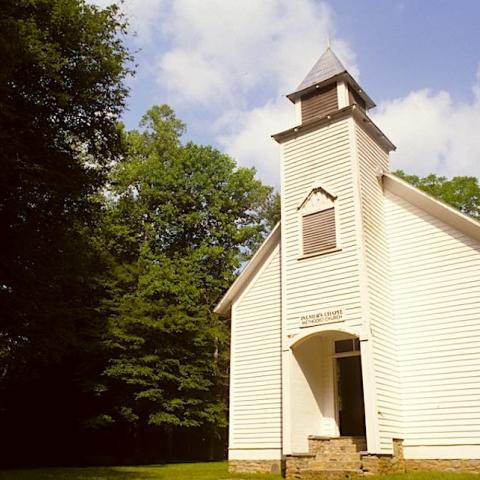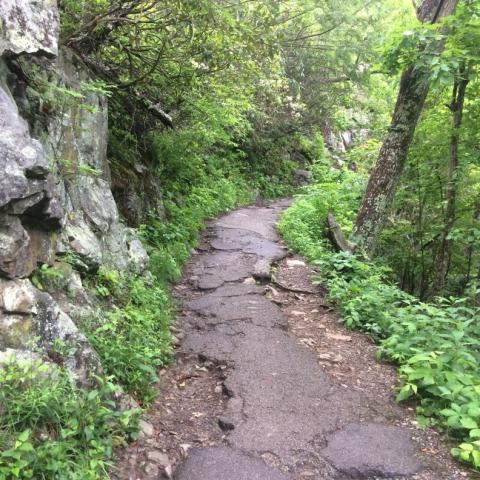
The Collections Preservation Center in Townsend, Tennessee/Danny Bernstein
In 1894, Sydney Ann Myers married Daniel Alexander Lawson in Cades Cove. Daniel built a chest of drawers as a wedding present for his bride. When they moved out of Cades Cove, the couple took the dresser with them.
Cades Cove is now a premier visiting area in Great Smoky Mountains National Park, most easily accessed from Townsend, Tennessee. Before the park came in, Cades Cove was one of the largest settlements and probably one of the wealthiest. The groom was related to the Lawson family who lived in the Dan Lawson Place, a cabin displayed on the Cades Cove loop.
When residents sold their land and moved out of the park, they left their older stuff, dating from about 1850 to 1900, and took their newer acquisitions with them. Now the historic dresser sits in the Collections Preservation Center (CPC), an archival and storage facility in Townsend, Tennessee.
The park started collecting pieces in 1931. At the time, Charles Grossman, who trained as an architect, identified what residents left when they moved. Grossman, along with Hiram Wilburn, an unofficial historian, traveled around the hills and documented structures and artifacts within the park boundaries during the 1930s and 1940s. The two men, and the park, understood that they had a one-shot opportunity to identify these artifacts.
Today, the CPC is a 14,000-square-foot climate-controlled building that houses 1.3 million archival records. The paper collection spans from 1780 to 2016, and includes land grants from the Revolutionary War and the War of 1812. There are historical artifacts, such as the dresser, farm implements, and even clothes. Arrowheads and shards are classified as archaeological items. The natural history collection, such as mounted plants and insects, is mostly stored at Twin Creeks Science Center.

Chest of Drawers, Collection Preservation Center/Danny Bernstein
In addition, the collection includes pieces from four other east Tennessee parks – Andrew Johnson National Historic Site, Big South Fork National Recreation Area, Cumberland Gap National Historical Park, and Obed Wild and Scenic River.
All these millions of documents and artifacts would not be useful, accessible, or even safe without the proper staff. I had the privilege to meet the two men responsible for protecting the collection.
Mike Aday, the archivist, describes himself as a “lone arranger”, a term that refers to archivists working alone or with a very small staff. With a Master’s degree in history, Aday was drawn to archival work.
“I didn’t want to be a history professor,” he says. Previously, he was the librarian in the Great Smoky Mountains National Park library, located under Sugarland Visitor Center. His salary is paid by the Great Smoky Mountains Association, the non-profit park partner that manages the park bookstores.
Aday works with researchers and genealogists, both professional and family. He spends a lot of time on outreach, giving talks about the CPC collection to many regional groups.
“But isn’t there already a lot of information about the families who left the park?” I ask.
“Every generation has to discover their lineage for themselves,” Aday replies. He answers questions like “Where do I start?”

Breathing apparatus in storage at Great Smoky Mountains Heritage Center/Danny Bernstein
The building has comfortable tables and chairs for researchers. Aday brings documents to the researchers; they can’t peruse the shelves on their own. Researchers have to use white gloves and take notes in pencil, a standard procedure in research libraries. Aday also has a two-way mirror, looking in from his office to the research area. When researchers are settled in among the documents they request, Aday comes around every 15 minutes to see if all is going well.
Baird Todd, originally from Montana, is a uniformed National Park Service employee. Armed with a Master’s degree in history from the University of Tennessee, he’s worked in several national parks, including Andrew Johnson National Historic Site. Now he’s the curator and the custodial official who worries about the protection of the collection, the building, and budgets.
“How do you decide what to accept into the collection?" I ask.
“In the case of the Lawson dresser, the name and genealogical information match up,” Todd explains. "The scope of the collection has to fit at least two criteria. It has to have been made or used by people in the park, and it has to be an item that can be preserved. We may not always do restoration on an artifact.”
Todd researches the artifact and presents his findings to a Collections Committee made up of NPS employees with experience in historic preservation that in turn make the final decision.
“We don’t buy anything. Everything has to be donated. The park will take better care than anyone else,” Todd says. The great-great granddaughter of the Lawsons donated the historic dresser to the CPC.
Aday and Todd take me into the main collection storage facility, where artifacts are catalogued and stored. Researchers can’t go in here by themselves. Since I wanted to see something from Andrew Johnson National Historic Site, one of my favorite historic parks, Todd points to Andrew Johnson’s travelling campaign desk. Campaign, in this case, doesn’t refer to military or political campaign.
“If you had enough money you could take your own desk with you when you traveled,” Todd says.
Most of the artifacts are from the Walker sisters, who left the Smokies in 1964. Their chairs, lots of chairs, went to the Great Smoky Mountains Association, then known as the Great Smoky Mountains Natural History Association. The Walker sisters also left the single largest collection of seeds.
The textile collection also includes men’s trousers, left in Cades Cove about 1935-36. The archivists don’t clean the pants.
The Lawson dresser, a four-drawer chest made out of poplar with a thick veneer, also resides in this storage facility. Each drawer is constructed as one piece. It looks similar to dressers available in the 1950s and 1960s. The big difference, of course, is the good provenance – the history of the piece, not something bought in a cheap urban furniture store.
Much of the collection is mandated by law, dating back to the Historic Sites Act of 1935, which starts:
It is declared that it is a national policy to preserve for public use historic sites, buildings, and objects of national significance for the inspiration and benefit of the people of the United States.
All the records created by the Park Service staff dating from its inception to the present are filed and available to researchers. For example, that includes all the decision documents made about the work to restore elk to the Cataloochee section of the Smokies in 2001.

Andrew Johnson's Campaign desk/Danny Bernstein
Finding the CPC
Townsend, Tennessee, bills itself as the “quiet side of the Smokies,” in contrast to Gatlinburg. It has fewer motels, restaurants, or amusements. Almost everyone drives to their destination, without worrying about parking.
The CPC building has no sign or Park Service arrowhead in front. The destination is described as the large building next door to the Great Smoky Mountains Heritage Center. When I asked local residents where the Collections Preservation Center was located, no one could tell me. Finally, I went up to a large, solid building. The entrance has a small arrowhead on the side of the door and a bell that you must ring to be let in.
The $4.2 million facility, opened in May 2016, was funded partly by the National Park Service and a $1.9 million donation from the Friends of the Smokies and Great Smoky Mountains Association. The land for the facility was donated by Great Smoky Mountains Heritage Center. Since CPC has no exhibit space, they lend items to the Heritage Center next door and the E. Tennessee Historical Society.
Great Smoky Mountains Heritage Center
Next door to the CPC, the Mountains Heritage Center http://www.gsmheritagecenter.org/ hosts displays ranging from native American artifacts dug up in Blount County to Appalachian cabins, one-room schools, and churches. Its National Parks Gallery rotates items from the CPC, including items from the four other east Tennessee national park units.
There’s a sewing machine from Andrew Johnson National Historic Site, reminding visitors that Johnson started out as a tailor. Hand-made quilts are displayed from Cumberland Gap National Historical Park. Walls are covered with modern kayaking and climbing equipment from Obed Wild and Scenic River. The Great Smokies section is filled with natural history displays of stuffed endangered species, such as Indiana bats, rare Eastern Spotted Skunks and Carolina Northern Flying Squirrel, classified as endangered under the Endangered Species Act.
For me, the highlight of the gallery comes from the mining activity in Big South Fork National River and Recration Area. The displays include Company Scrip, coins with a moon-shaped cente, issued by the Sterns Coal and Lumber Co. that were used for payment at the company store and used until 1964 – I owe my soul to the company store.
The most interesting piece from the mine has to be the self-contained breathing apparatus meant to be used for mine rescues by miners and rescuers alike. A Lisk lunch pail, miners’ helmet, and lamp round out the picture of mining in Kentucky.
How to visit the CPC
To visit the CPC and research your family or a historic topic, you must have an appointment. Go to the CPC website for contact information.
The Great Smoky Mountains Association is hosting a public tour of the facility on Friday, May 17.




 Support Essential Coverage of Essential Places
Support Essential Coverage of Essential Places







Comments
A minor correction.
The Great Smoky Mountains Association tour is already sold out.
To join the tour, you need to be a Great Smoky Mountains Association member, a good reason to join - maybe for next year.
Danny Bernstein
(the author of the article)
Why can this not be operated as a museum instead of a highly controlled and staffed warehouse for appointments only?
Obviously, backpacker, you don't know much about the profession of conservators. I suggest you find out more.
Oh please , Rick B , spare us the lecture. The Mona Lisa is viewed by the public. Are you telling us old dressers and" Bear in the Backseat "style papers ( elk documentation )can't be viewed by the people the law intended to preserve the items for in the first place? Quit catorigizing the American public as Ceasars and slaves.
Caesars and slaves? Quit putting silly words in my mouth.
I'm married to a museum professional and in general I respect their informed choices about preserving and protecting their artifacts.
Have reason to believe that the lawsons of webster county missouri came here from cades cove tn. Charles E. Lawson Fordland Missouri
Highlands, intelligencia and proletariat would be more appropriate.